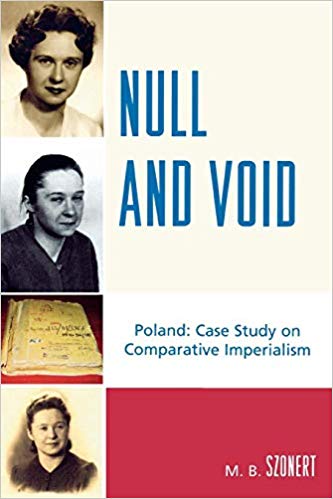Zydokomuna BEZPIEKA Leaders Szonert

Null and Void: Poland: Case Study on Comparative Imperialism, by M. B. Szonert. 2008
A Broad Overview of Recent Polish History. BEZPIEKA and Zydokomuna
This work covers many topics: WWII battles, Katyn, the deportations of Poles into the USSR and Nazi Germany, the Soviet-betrayed Warsaw Uprising, the Roosevelt-Churchill betrayal of Poland, the Soviet-imposed Communist puppet state, the illusory Gomulka “thaw”, the election of Pope John Paul II (JPII), the Solidarity movement, the Jaruzelski-imposed martial law, the fall of Communism, and the first decade of post-Communist Poland.
Two things stand out about this work. One of them is the detailed description of the provocations against Poland conducted by Nazi Germany, as well as Poland’s German minority, in the year or so before the 1939 German-Soviet conquest of Poland. (p. 15-on). Another is the detailed descriptions given to the Communist terror in Yalta-betrayed Poland, and the sufferings of the people under Communism.
THE SCOPE AND SCALE OF THE ZYDOKOMUNA
The author is candid about the very disproportionate number of Jewish officers in the hated Communist security forces (the UB, U.B., or Bezpieka). She writes: “The entire managerial cadre of the Public Security Ministry came with the Soviet Army from the East. Initially, the decision makers in the newly formed Polish administration were only Russians; many of them didn’t even speak Polish. Polish Jews together with a few Poles, all of them trained in Moscow, occupied the second tier of the managerial structure. The ordinary Poles were working mainly in the lower levels of the administrative structures. By 1948, most of the Soviets returned to the Soviet Union, leaving the Polish Jews firmly in charge. Stalin favored Jews over Poles. He trusted them more because the Polish Jews were less likely to be connected with the patriotic movement, were outsiders towards Polish history and tradition, and had no ties to the Catholic Church.” (pp. 112-113).
WARNING: The accounts of Communist tortures are graphic, and may upset the sensitive reader. In summary, Szonert cites sources that affirm the following: “It is estimated that between 1945 and 1948 at least 2,500 death sentences were handed down, while another 10,000 people were murdered during barbaric interrogations, not even reaching trial. In addition to those murdered, between 100,000 and 150,000 people were sentenced to lengthy prison terms, many of them died in prison of inhumane conditions and lack of medical care; some of them were brutally murdered by prison killers, so called URKAS…” (p. 126).
To see a series of truncated reviews in a Category click on that Category:
- All reviews
- Anti-Christian Tendencies
- Anti-Polish Trends
- Censorship on Poles and Jews
- Communization of Poland
- Cultural Marxism
- German Guilt Dilution
- Holocaust Industry
- Interwar Polish-Jewish Relations
- Jewish Collaboration
- Jewish Economic Dominance
- Jews Antagonize Poland
- Jews Not Faultless
- Jews' Holocaust Dominates
- Jews' Holocaust Non-Special
- Nazi Crimes and Communist Crimes Were Equal
- Opinion-Forming Anti-Polonism
- Pogrom Mongering
- Poland in World War II
- Polish Jew-Rescue Ingratitude
- Polish Nationalism
- Polish Non-Complicity
- Polish-Ukrainian Relations
- Polokaust
- Premodern Poland
- Recent Polish-Jewish Relations
- The Decadent West
- The Jew as Other
- Understanding Nazi Germany
- Why Jews a "Problem"
- Zydokomuna